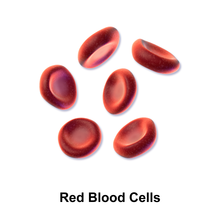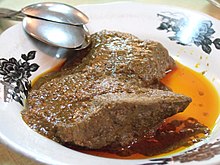Healthy eating habits/Iron for Young Women
This page provides information on how young women can meet their iron requirements. Iron is a particularly important nutrient for women of child bearing years (19-50 years of age) and not meeting iron requirements may affect both energy levels and brain functioning.[1]

Iron in the body
[edit | edit source]Why do I need Iron?
[edit | edit source]Iron has many important roles in the body.
- It is essential for oxygen transport in the blood and muscles.
- It is a component in pathways that release energy from food for the body to use.
- It has important roles in maintaining immunity [2]
How much Iron do I need?
[edit | edit source]Iron is a trace mineral, this means, it is only required by the body in small amounts.
- For women of child bearing years (19-50 years of age): 18mg/day is recommended (without exceeding 45mg/day).[3]
- However, for women of child bearing years who follow a vegetarian diet, almost twice as much iron is recommended: 32mg/day. [2]
This is due to plant based iron sources being less readily absorbed by the body than animal based iron sources.
Iron Deficiency
[edit | edit source]Iron Deficiency occurs when the body's iron stores are low. This is different to Iron deficiency anaemia, which is a significant reduction of iron stores, that results in the blood's inability to deliver sufficient oxygen to the tissues of the body and energy producing pathways in the body are compromised [4]
Symptoms of Iron deficiency depend on the degree of Iron deficiency and include: decreased energy, breathlessness, pale skin, lack of concentration [2]
WHY are young women at risk?
|
Iron Toxicity
[edit | edit source]Iron overload or toxicity is uncommon, as Iron is tightly regulated by the body. It may however occur in the following cases:
- Haemochromatosis: a genetic condition that causes disruptions in the body's iron regulatory systems resulting in an increase in iron absorption and causing a build up of Iron in the body.[1]
- If an excessive amount of iron supplements are taken.[1]
Symptoms may include gastrointestinal side effects such as constipation, nausea, vomiting and diarrhoea. [2]
It is therefore important not to exceed 45mg of Iron per day. [3]
Iron in the diet
[edit | edit source]Iron is found in two forms in the Diet. Haem Iron and Non- Haem iron
Haem Iron
[edit | edit source]- Only found in animal products
- More easily absorbed by the body.
- 25% of Haem iron is absorbed. [2]
Non-Haem Iron
[edit | edit source]- Found in both animal and plant products
- Less easily absorbed by the body.
- 17% of non-haem iron is absorbed.[2]
Food Sources of Iron
[edit | edit source]Haem Food Sources
[edit | edit source]
| Food Source | Serving Size | Iron Content (mg) |
|---|---|---|
| Chicken Liver | 100g, cooked | 13mg |
| Beef Liver | 100g, grilled | 6.5mg |
| Beef, lean | 100g, grilled | 3mg |
| Lamb, lean | 100g, cooked | 2.5mg-3mg |
| Turkey | 100g, cooked | 2.3mg |
| Chicken | 100g, cooked | 1.3mg |
| Fish (white) | 100g, cooked | 1mg |
| Tuna | 100g, canned | 1mg |
| Pork | 100g, cooked | 0.8mg |



Non Haem Food Sources
[edit | edit source]| Food Group | Food Source | Serving Size | Iron Content |
|---|---|---|---|
| Grains & Cereals |
Iron fortified Breakfast cereals Eg. Weetbix |
2 biscuits, one cup (30g) | 3-4mg |
| Iron fortified bread Eg. Burgen wholemeal bread, Wonder White wholemeal bread plus Iron |
1 slice | 2-4mg | |
| Quinoa | 1 cup, cooked (1/4 cup raw) | 4mg | |
| Brown rice | 1 cup, cooked (150g) | 1mg | |
| Vegetables | Green leafy vegetables Eg. Spinach, kale, rocket |
1 cup | 4-5mg |
| Asparagus | 5 spears, canned | 2mg | |
| Broccoli | 100g | 1mg | |
| Avocado | 1/2 medium | 1mg | |
| Fruit | Dried apricots | 4 dried apricots (8 dried apricot halves) |
1.8mg |
| Meat alternatives |
Tofu (firm) | 1/2 cup | 2-3mg |
| Cashews | handful (30g) | 1.5-2mg | |
| Lentils | 1/2 cup cooked | 2-3mg | |
| Herbs | Parsley | 1 cup (25g) | 0.7g |
All information retrieved from [5] and [6]
Nutrient Interactions
[edit | edit source]Factors Increasing Iron absorption
[edit | edit source]- Including Vitamin C food sources in a meal, increases the absorption of non-haem iron sources.
Vitamin C food sources include: Tomato, capsicum, citrus fruits (such as orange, lemon, lime), strawberries, kiwifruit, broccoli.
- Including haem sources of iron in meal, increases the absorption of non-haem iron sources.
For eg. including meat products in a salad with green leafy vegetables.
- Cooking vegetables helps to increase non-haem iron absorption [7]
Factors Decreasing Iron absorption
[edit | edit source]- Chemical compounds such as: tannins, found in tea, coffee and red wine can interfere with the absorption of iron by the body.
- Chemical compounds such as: phytates, found in bran, some legumes and some nuts.
- Calcium can reduce non-haem iron absorption. [7]
Planning an Iron Rich Meal
[edit | edit source]- For Breakfast choose Iron fortified cereal or bread (see section 3.2) and add Vitamin C with fruits such as strawberries or kiwifruit or a glass of orange juice.
- Include haem iron (animal based products) in green leafy salads or for a vegetarian option, include vitamin C sources, for eg. tomotoes or a citrus-based dressing to help the body absorb non-haem iron sources (plant based products).
- Snack on high iron foods such as cashews or dried apricots.
- Cook vegetables helps to increase iron absorption from plant foods (non haem iron sources).
Additional Resources
[edit | edit source]- For additional information regarding iron content of food: Nuttab
- For further information regarding Iron: Better Health Channel
- For information regarding meeting Iron requirements: Nutrient Reference Values
References
[edit | edit source]- ↑ a b c d Thomas, B. & Bishop, J. (Eds). (2007). Manual of Dietetic Practice. (4th edition). Carlton, Victoria: Blackwell Publishing
- ↑ a b c d e f g Whitney, E., Rolfes, S.H., Crowe, T., Cameron-Smith, D.& Walsh, A. (2011). Understanding Nutrition. South Melbourne, VIC: Cengage Learning.
- ↑ a b c National Health and Medical Research Council, NHMRC. (2006). Nutrient Reference Values for Australia and New Zealand: Iron. Retrieved from: https://www.nrv.gov.au/nutrients/iron
- ↑ Better Health Channel. (2012). Iron deficiency- Adults. Retrieved from: http://www.betterhealth.vic.gov.au/bhcv2/bhcarticles.nsf/pages/Iron_deficiency_adults?open
- ↑ Food Standards Australia and New Zealand, FSANZ. (2013). Nuttab online searchable database. Retreieved from: http://www.foodstandards.gov.au/science/monitoringnutrients/nutrientables/nuttab/Pages/default.aspx
- ↑ Kouris-Blazos, A. (2012). Food Sources of Nutrients: A ready reckoner of Macronutrients, micronutrients and phytonutrients and Chemicals. Sydney: Dr. Antigone Kouris-Blazos.
- ↑ a b Better Health Channel. (2014). Iron. Retrieved from: http://www.betterhealth.vic.gov.au/bhcv2/bhcarticles.nsf/pages/Iron_explained
